Not every knee injury or condition requires surgery.
It's generally understood by doctors and surgeons that surgery will introduce more scar tissue into your knee. This added scar tissue will be problematic, requiring visits to the physio clinic and conservative treatment options post-surgery. If not dealt with properly, your knee could end up in worse condition than before the surgery! This is why surgery is only performed as a last resort.
Most doctors, surgeons and orthopedic specialists will recommend conservative therapy for minor knee injuries before even considering surgery.
Some of the most effective conservative treatment methods you will find are:


For acute (new or recent) knee injuries that have the ability to heal on their own - your doctor may even suggest use of a removable knee brace. A removable knee brace can be very helpful to prepare you for physical therapy sessions and mobility exercises.
Prolonged use of a removable knee brace or long-term rest (restricted movement) without proper exercise or stretching can make your joint injury worse.
If your knee remains completely immobilized and at constant rest, the edges of your soft tissue tear will begin to fill in with scar tissue as part of the healing process. You may also have on-going symptoms of pain, swelling, inflammation, and even poor blood flow circulation.
Good blood circulation is important because lack of proper blood flow will reduce the healing rate and healthiness of your soft tissue. Lack of blood flow and movement may facilitate atrophy (weakening and shortening of soft tissue) and scar tissue growth may increase as well. Soft tissue in your foot will tighten, decreasing flexibility and range of motion. Your ability to put weight on, flex, twist or pivot your foot in certain activities such as running, jumping, or going up and down stairs all become compromised. This puts you at a highly increased risk of greater injury so be sure that you are getting blood flow to the area.
Have you ever asked yourself this question? Here at MendMyKnee we've had this question asked of us for years. We've created this web page to answer this any many other related knee injury questions.

If our body is capable of healing our own injuries, why does it take so long to heal - and in some cases, why does no healing occur at all?
When we have a ligament, tendon, meniscus or other soft tissue knee injury, the tissue is damaged. Your body responds to this damage with healing right away. During this healing process your knee's tissue spasms and this contraction is meant to hold the tissue still to prevent any further injury. Swelling and inflammation is your body's way of sending blood to the area to start healing. Healing at this point will also expand the blood vessels in the injured tissue - they enlarge and swell causing you pain. This pain is a signal for you to lessen activity that would put anymore undue stress on your knee injury. It also acts as a reminder that you have an injury.
Why are knee injuries so hard to overcome?
In two words - scar tissue.

Tendons, ligaments, the menisci and other soft tissue in the knee are all meant to be soft and flexible, ready to work and move extreme forces in everyday activities. Damaged tissue heals with scar tissue; little tiny band-aids that overlap each other on the tissue mending the injury. With the added scar tissue the muscle, tendons, ligaments, menisci become rigid, less ready to move and unable to receive the full force of your movements. If you're suffering with scar tissue now you may feel the effects with stiffness, tightness, weakness and tiredness in your knee.
Scar tissue can form fast to bring together the edges of a tear, but working fast doesn't mean that the job's done right. When scar tissue forms it doesn't come together as neatly as regular (healthy) tissue would. Scar tissue fibers will lay down over top of your tear in a cluttered, messy and jumbled up way.
On-going issues with scar tissue can even result in a soft tissue tear, related soft tissue injuries to nearby tendons or ligaments, knee joint instability, or surgery may be required to fix your knee injury.
Scar tissue is one of the MAIN reasons why a knee injury just hasn't healed.
Scar tissue will form fast to deal with a knee injury, and this scar tissue will also attach to everything in the area, including the surrounding healthy tissue as well. This can result in a fusing together of the soft tissue in the knee that reduces your mobility and makes your injury even more painful! This is why physical therapy is often painful - the therapist stretches the joint, forcing the scar tissue bonds to break so you can regain your range of motion.
Scar tissue is a major problem especially when it comes to a knee injury - causing your injury to take months or even YEARS to completely heal!
You can quickly soften scar tissue and prevent further injury to your knee by increasing blood flow to that area. Treating yourself with a Knee TShellz Wrap is a simple, safe and effective way to deal with stubborn scar tissue at home.
When applied before activity or work, the TShellz Wrap will also relax and lengthen your soft tissue to help improve your range of motion and prevent atrophy (wasting away and shortening of muscle tissue) of your injured knee.
Overall, continued treatment with a Knee TShellz Wrap will maintain good health in your soft tissue and significantly reduce your risk of re-injury.
If your doctor thinks you might be able to avoid surgery by using conservative treatments, you can join our many customers who have had great success treating themselves with the powerful treatment products we offer through MendMyKnee.
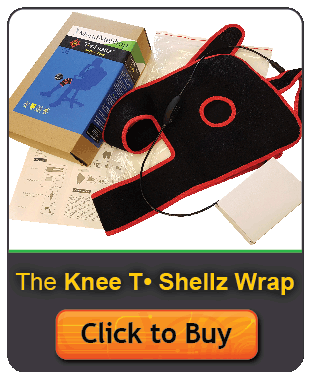
Knee injuries can happen to anyone and right now there are thousands of doctors and physical therapists delaing with patients that require a solution to treat their knee injury fast and heal it (where possible). If you want to be pro-active about properly addressing your knee injury, speak to your doctor about adding to your treatment with MendMyKnee's system utilizing Circulatory Boost Therapy via the KNEE TShellz Wrap®.
Ok, well the good news is that MendMyKnee conservative treatments are intended to be highly effective for post-surgery recovery. Read more about how to get started with post-surgery recovery.
The type of surgery you will have depends on the type of knee injury you're suffering from. The longer you've waited to have surgery will also be a factor that determines the type of sugery that's needed.
With acute (recent) tearing the stretch or tear in your tendon/ligament or the damage to your bursa/meniscus may be minimal. If you have an acute tear that is relatively small you may qualify for less invasive surgery (like an arthroscopic procedure). Surgeons will always choose a shorter, less invasive procedure if it's possible to do so. Most surgeons know that a less complicated procedure will have less trauma to your knee and a much quicker rate of recovery after the surgery.
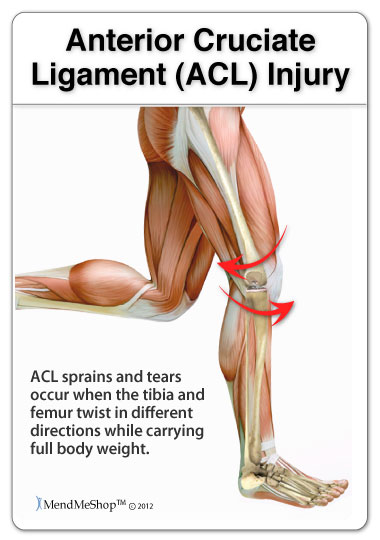
If you're suffering from a chronic knee injury or tissue tear that's been going on for a while (from overuse/repetitive movement) or has been damaged due to aging of your tissue then you may have less options available for surgery. A repair of the tissue, for example, is usually only ever performed for newer (acute) tissue tears where it is possible for the tissue to heal back together. If you have a chronic knee injury there may be more fraying to your ligament or tendon tissue. If you suffer from chronic knee bursitis, it's likely that you also have another soft tissue knee injury (like tendonitis or a torn ligament) that keeps causing your bursitis to recur. In either case arthroscopic surgery may be enough to fix your knee but the amount of tissue that can be repaired will depend on how worn away/frayed (degenerative) your tissue damage is.
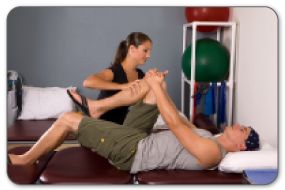
Your age will also be a factor. Surgery is generally used more often for younger patients requiring a repair to a tendon or ligament tear. Conservative treatment methods and physical therapy are recommended (instead of surgery) for older patients suffering from the same type of injury. (reference: https://www.emedicinehealth.com/knee_injury/page6_em.htm [Jan 2023])
Even if surgery is required to treat your knee injury, your surgeon may still recommend physical therapy before the procedure. This is sometimes recommended so you may strengthen your quadriceps and hamstring muscles. This is done to help with your post-surgery rehabilitation and speed up post-surgery healing of your knee.
Yes, there are a vast number of surgeries performed on the knee throughout the world, but there are really only 2 surgery methods. They are arthroscopic surgery and open surgery - and it matters because (statistically speaking) recovery time length will probably depend a lot on the method of surgery that is undertaken.
There are 2 main types of surgery: knee arthroscopy and open knee surgery. Arthroscopy is by far the most common procedure used when performing a knee surgery. It's a doctor or surgeon's preference to perform an arthroscopy whenever possible, because it's the least invasive surgical procedure and usually has the quickest form of rehabilitation afterward.
Whether you'll qualify for an arthroscopy depends on the severity and type of injury that you have. In many cases, arthroscopy is also used to examine an injury for diagnosis, because this procedure is done with a thin tube containing a camera and light inserted through an incision near the knee joint. This type of surgery will provide the surgeon with a direct look into your injury and help to limit the amount of additional damage from surgery. During this surgery your doctor will only make 2 to 3 keyhole incisions (less than 1 inch in length) to insert the thin tube with the camera, an irrigation instrument and any surgical tools they will need to fix your knee. There will be minimal surface damage to your knee and in some cases; the tiny incisions won't even require stitches to heal.
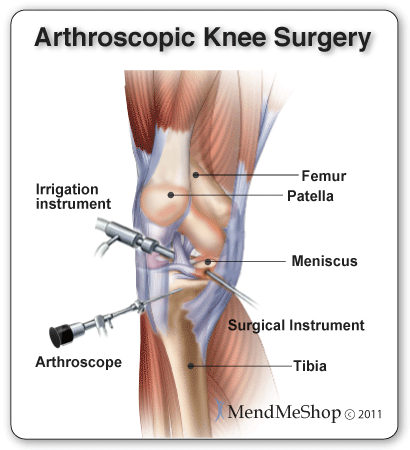
If you suffer from a more severe knee injury you may need to have an open knee surgery to give the surgeon a better view of your injury and more room to move the surgical tools around if your injury is complicated to fix.
When researching your options for surgery you may find more information available about arthroscopic surgery. This is because arthroscopy is considered to be the gold standard for knee surgery, meaning that many surgeons prefer to perform an arthroscopy to minimize the how invasive your surgery is. Most doctors and surgeons will automatically consider you for arthroscopy whenever possible to provide you with the fastest rehabilitation and recovery option after surgery.
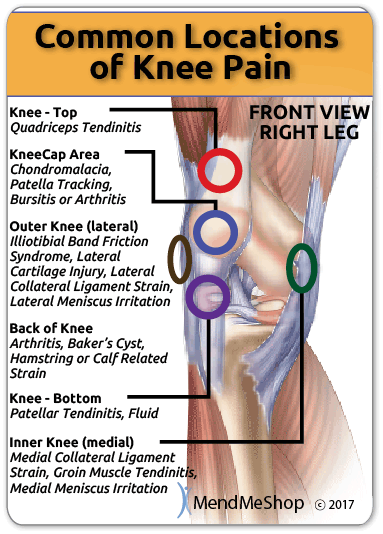
If, however, you have a severe injury - like a full tissue tear, an open wound from a traumatic event or an accident, bone damage, displacement or fracture, or require a full knee replacement - then you will probably have to undergo an open knee surgery.
In an open knee surgery your incision could be 6 to 10 inches in length, or longer if you already have an open wound. During the surgery, instead of making a few keyhole incisions like in the arthroscopy, your surgeon will open up your knee to see the inside joint. This means your surgeon will cut through your skin and the muscle underneath to see your injury. Open knee surgery will probably leave a scar on your knee. The possibility of a scar is yet another reason why surgeons will avoid open surgery wherever possible.
Arthroscopy is considered an outpatient surgery (most of the time you can leave the hospital the same day as your surgery), open surgery is considered an inpatient surgery (you'll have to stay overnight or maybe even longer).
Living with pain is never easy as it affects your entire lifestyle. Living with pain during or after an intensive surgery and lengthy rehabilitation period can be even harder! What is more important than taking your best shot at improving your knee without getting surgery?
Technology and surgery methods are constantly improving in the medical industry, and results from knee surgery are much more positive than they were in the past. However, all surgeries introduce scar tissue and recovery from the surgery will center on the same issues addressed earlier - elimination of scar tissue, strengthening of soft tissue (tendons,ligaments,muscle) in the knee and increasing the Range of Motion (ROM) in the knee joint. Generally, post-op recovery is about you working toward having a strong, flexible and stable knee joint. This even holds true for knee replacements and/or implants - the goal is always the same. Rehabilitation at-home while attending regular physical therapy is vital for your overall recovery time. Once your PT or Physician agrees you are recovered enough to do so, gentle stretching and conservative home treatments on a daily basis will speed your recovery. PT appointments are often once or twice a week and often limited in duration due to insurance coverage, but you can treat yourself at home every single day.
MendMyKnee stands out in this regard as our goal is to help you get and keep your knee healthy for the long-term in a cost effective manner. If surgery can't be avoided, then our tools can help you recover from surgery more quickly and completely.
We are quite confident that we can help you, as we have many happy clients to back this claim. You are welcome to try our products for a 60 day period. If you are committed to following the treatments outlined in the product instructions we are very confident that our TShellz Wraps and Cold Compresses will aid you immensely. If you do not receive the benefits that countless of our other customers have experienced by the end of the trial period we will provide you with a full product refund (once you send the product back).

Click HERE to Go To Our Online Store We take all major credit cards and Paypal. If you are on your mobile phone, Click to Call Our Office (toll free continental NA).
Our customer service lines are open 5 days a week (Mon-Fri) helping people understand their injuries and if they may gain a benefit from our products. Simply call toll free 1-866-237-9608 to talk with one of our knowledgeable Product Advisors. They have the ability to answer questions and even put together a treatment plan for you.
Product Advisors are available 9:00 am to 5:00 pm Eastern Standard Time Monday to Friday.
Learn more about Knee Surgery and Post-Surgery Recovery
Learn more about how the TShellz Wrap® stimulates blood flow.
Learn more about Ice vs Heat Treatments for Knee Strain
During your recovery, you will probably have to modify and/or eliminate any activities that cause pain or discomfort at the location of your soft tissue injury until the pain and inflammation settle. The more diligent you are with your treatment and rehabilitation, the faster you will see successful results!
Please be aware that this information is neither intended nor implied to be a substitute for professional medical advice. CALL YOUR HEALTHCARE PROVIDER IMMEDIATELY IF YOU THINK YOU MAY HAVE A MEDICAL EMERGENCY. Always seek the advice of your physician or other qualified health provider before using any of our outstanding products to make sure they are right for you and your condition or if you have any questions regarding a medical condition. Always see your doctor for a proper diagnosis as there are often many injuries and conditions (some very serious) that could be the cause of your pain.
© 2025 In.Genu Design Group, Inc. Contact Us